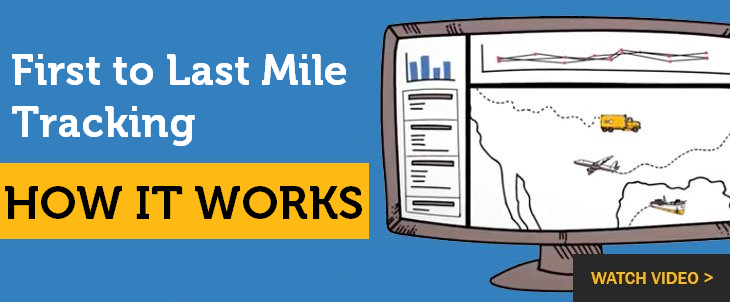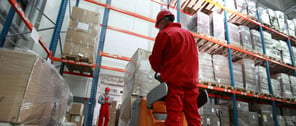Amazonification has been a positive influence for B2B & B2C supply chains, spurring steady improvement in the efficiency, quality, and reliability of logistics operations, especially those related to last mile delivery.
Although companies continue to squeeze their last mile for more efficiency, more cost reduction, and more predictability, the improvements they see are bound to plateau sooner or later.
It’s about time we address the larger elephant in the room — first mile delivery optimization — and dig into a largely untapped reserve of lead time reduction and opportunities to decrease costs.
Thanks to end-to-end shipment tracking and supply chain visibility solutions, it’s getting a lot easier.
Why is the Last Mile Usually the First Target for Optimization?
Last mile delivery.
Those three words are enough to make even the hardiest supply chain manager cringe.
Companies like UPS, DHL, and FedEx have been trying to perfect their last mile deliveries for decades; the United States Postal Service has been trying to for centuries.
A combination of the Internet, e-commerce, and the Amazon effect has spurred several innovations to reduce the inherent inefficiencies and delays in last-mile delivery. New developments in automated warehouses and distribution centers, inventory picking optimization, and the decentralization of infrastructure have made the tail end (warehouse to customer) of the supply chain incredibly efficient.
The challenges faced around the entry and flow of cargo through the first mile are similar to what is experienced in the last mile. And yet, the first mile is often neglected or overlooked when it comes to investing time and effort toward improvement.
Why the dramatic difference in concern and corrective action?
It usually boils down to two reasons:
- Customer Satisfaction
Last-mile delivery is the shortest step of a very long process, but it’s usually the only point of contact between a company and its customer. The delivery experience — whether it was on time, in full, and in proper condition — is a huge factor that determines customer satisfaction, and the likelihood of repeat business. Rising customer expectations and growing competition have played a huge part in the decision to prioritize the improvements in the last mile. - Transportation Cost
Besides being a key contributor to customer satisfaction, last mile delivery is also the most expensive leg of a supply chain, it usually accounts for 30%-40% of the total delivery cost.
Most companies prefer spending time and effort for last mile delivery optimization because they think it’s easy.
Well, not easy, but definitely easier than improving the first mile anyway.
Although there may be more variables to deal with in last mile delivery, most are well within a supply chain manager’s sphere of influence.
Some of the factors responsible for inefficiency in the first mile — unpredictable unloading or detention time at ports, unexpected delays at customs or at an intermediate facility, or even the weather — are completely beyond the control of even the best laid supply chain strategies, which is why supply chain managers have been forced to adapt their last mile to accommodate (and compensate for) inefficiencies in their first mile.
The Last Mile is Important, But it’s Not the Most Important
Supply chains, carriers, 3PLs, everyone who’s been in business long enough has B2B delivery down to a science. Most are hell-bent on neutralizing their last mile challenges.
Compared to streamlined last mile shipping and warehouse logistics operations, the inefficiencies in the first mile can be, for lack of a better word, startling.
Limited control, crude cost model management, inefficient (sometimes even non-existent!) long-haul route optimization, poor less-than-truck-load (LTL) shipment management, and a negligible ability to track carrier performance KPIs beyond simple cost metrics – these are just some of the issues in first mile delivery optimization that haven’t been sufficiently addressed.
This is a cause for concern because:
- Goods Spend Much More Time Getting Through the First Mile Than the Last Mile
It’s ironic that most of the effort to optimize transit time is focused on the last mile, where shipments spend the least amount of time. The first mile is rife with logistics black holes — the time taken to assemble and pack shipments, transit time over slow modes of transport like ocean or rail, the time containers spend idling at ports, detention, or inspection facilities — it all adds up to longer lead time. - Inefficiency in the First Mile Has a Domino Effect
Missing the window of drop-off or loading for a container ship or freight train could add anywhere from a few days to a few weeks to the lead time. Unpredictable transit time and tight order fulfilment SLAs also mean several companies routinely hold high levels of safety stock to accommodate unpredictable inventory lead time. That isn’t just a setback to streamlining operations to a lean inventory model; it builds up inventory holding costs, working capital, and other hidden costs that ultimately erode profit margins.
Organizations cannot afford this lack of control in the first mile.
Not only do unnecessary delays and costs pile up, they also spill over into the last mile, especially for manufacturing companies that don’t have the option of nearshoring a portion of their procurement to offset inefficient offshore supply chains with long lead times.
First mile inefficiencies can cascade into last mile issues like short orders, stock-outs, as well as the skyrocketing costs of local warehousing and holding safety stock — undermining the performance of what could be a more optimized last mile supply chain.
Working on improving efficiency in the smallest part of the supply chain while ignoring the larger scheme is an exercise in futility that needs to be addressed.
Why Haven't They Fixed the First Mile?
To put it simply, it’s because they don’t know where to begin.
An abundance of variables that affect efficiency coupled with an inability to effectively track them mean there’s no clear way to know exactly what’s running slow, or why. There’s no clear visibility of inventory location or movement, and there’s little to no insight into lane or carrier performance either.
Some of the most common reasons why first mile delivery optimization remains a pipe dream include:
- Concerns about the cost-effectiveness of change — like replacing long-term arrangements with a more agile approach to carrier selection, or the probative cost of deploying end-to-end supply chain tracking systems.
- The difficulty of uprooting and updating well-established routes or processes — despite the fact that some of them are very outdated or inefficient.
- A fear of disruption — and the cascading effect that it could have on current processes as well as customer experience, satisfaction, and attrition.
When weighed against more pressing concerns like the need to focus on customer satisfaction, the sheer cost and complexity of any attempts to analyze and improve the first mile delivery process dissuades most organizations from trying to improve theirs.
How Do You Improve First Mile Delivery?
To put it plainly, you need identify scope for first mile transit time reduction.
- Start by tracking the movement of goods through every part of the first mile.
For manufacturers, this could span from the procurement of raw materials on to the assembly and delivery of a semi-finished/finished product to a distributor or regional warehouse. It’s easier now thanks to low-cost wireless GPS tracking devices that can track shipments and inventory anytime, anywhere.
Identify every stop, facility, and activity that’s involved for each route. - Measure and log, everything.
Track transit time relative to shipment size, mode of transport, route, as well as stops, capacity and throughput at intermediate facilities like docks, warehouses, or repackaging facilities. Cross-reference with time, geography, congestion (on the road, at a port, or within a facility) as well as weather conditions as well for a more complete picture.
Identify everything that can directly or indirectly affect transit time for every route and setup. - Plan, prioritize, and proceed cautiously.
Once you’ve identified areas where there’s scope to reduce transit time — like better routes, faster lanes, more efficient carriers, or idle time when shipments wait for pickup, for example — while still keeping operating costs minimal.
Identify optimal logistics plans — yes, plans — that you can put into play to reduce delays in the first mile.
If you think it’s not as easy as it sounds, you’re probably right.
It is possible however.
Several companies that invest the time and effort to get it done see an improvement in first mile delivery time reduction and supply chain predictability, sometimes even enough to merit switching to a Just-in-time (JIT) inbound model that can reduce operating costs and boost profitability further.
Supply Chain Visibility — The Key to First & Last Mile Delivery Optimization
A growing need to squeeze out unnecessary supply chain operating costs is spurring organizations — whether they’re into manufacturing, logistics, or consumer goods — to adopt more agile and efficient supply chain models (for both inbound and last mile operations) using real-time supply chain visibility.
The right lane, the right carrier, and the right time for dispatch — picking the right combination is the key to achieving transit time reduction and deliver the best service and reliability possible, while still keeping costs low.
A number of cloud-based supply chain tracking and analytics systems available right now are designed to help do just that, while reducing the need for complex, expensive, and possibly disruptive changes during the initial implementation.
A combination of live shipment tracking, advanced analytics, and a constellation of mobile devices can help deliver better supply chain transparency, end-to-end visibility, superior customer service, and most importantly — better cost control.
The last mile is getting faster, more efficient, and more effective than it’s ever been.
It’s about time the first mile caught up.













